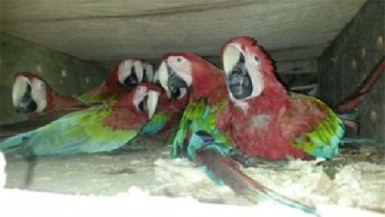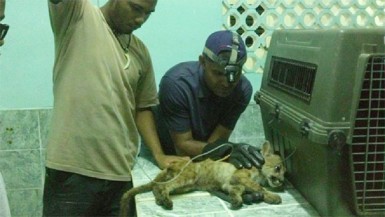A young puma and several other wild animals were yesterday retrieved by the Ministry of Natural Resources and the Environment after a woman was found transporting them to Georgetown from South Rupununi.
The Ministry and the Environmental Protection Agency (EPA) had responded to a report received from Iwokrama of a Toyota 4×4 pickup loaded with several wildlife species, including a juvenile puma, being transported to Georgetown.
The EPA said the woman was not in possession of any permit to capture or transport the animal, which had originally been identified as a jaguar. As a result, she was instructed to report at every police outpost/station en route from Kurupukari to Georgetown.


When the woman and a vehicle loaded with animals arrived at the Brickdam Police Station under police escort, the young puma was handed over to the Guyana Zoo.
According to a statement from the ministry, Shonette Thakurdeen presented a Veterinary Health Export Certificate signed by a Plant Health Inspector, dated September 2, which indicated that 30 red and green macaws, a tapir, a capybara, and a cat were examined on request of a Colin Thakurdeen and the animals were to be shipped to an export base in Georgetown.
However, when Takurdeen met with the EPA team along the Linden-Soesdyke Highway, the cat was identified as a puma instead of a jaguar as was originally identified on the permit.
The puma, which was housed in small wooden crate during its journey from South Rupununi to the Zoological Park, was examined by Dr. Nardeo Basdeo and was found to be greatly dehydrated and extremely weak.
“He was subsequently removed from the filthy crate and rehydrated using saline solution. A shot of penicillin was then administered,” the ministry said. It added that the puma was transferred to a larger clean crate and observed for a short period until he had calm down enough to be safely assessed further.
The other wildlife animals were also found to be highly dehydrated and with a number of open wounds and other injuries.
All species of wildcats in Guyana are deemed “protected” and under the Wildlife Management and Conservation Regulations, “protected” means in relation to wildlife, collecting, holding in captivity, hunting, killing or otherwise molesting is prohibited.
The ministry said Takurdeen is expected to be charged soon under the new Wildlife Management Regulations over having in her possession an illegally captured young puma, the poor treatment of the animals and other aspects related to the condition of wildlife being transported.




